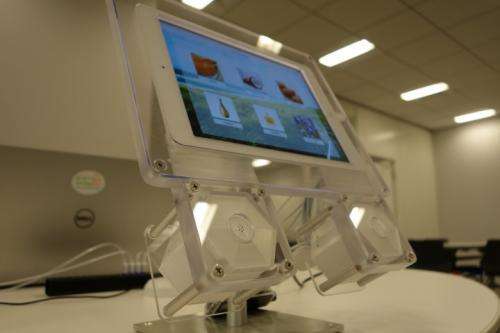December 5, 2014 weblog
Aromajoin gets in the stream of digital olfaction age

(Phys.org) —Welcome to the digital olfaction age. From Tokyo to Haifa to Berlin, scientists are keen to demonstrate their work to push digital olfaction along, whether they are talking about digital olfactory nanoarrays for disease detection, to growing a unique kind of online fragrance marketplace, to food industry use for quality and safety control. The potential for our screens to give us information through smell, beyond clever copy-writing and high-resolution images, can raise our knowledge and perceptions about food and whatever else is being relayed. Research in this area has been written about before.
Last year, researchers at the Tokyo University of Agriculture and Technology showed off their olfactory display relying on two odor-releasing vents—one on the right side, the other on the left of an LCD TV screen—programmed to dispense up to eight different aromas. "The Smelling Screen" was designed to fit inside a living room. The prototype demonstrated measured 32 centimeters in height and 53 cm in length—about the size of a large personal computer monitor. The vents released odors automatically at preset intervals. A pair of fans blew odors in various directions and created the illusion that the scent was coming from a specific point or object on the screen.
Dr Marvin Edeas, chairman and founder of the Digital Olfaction Society, said, "The digitization of olfaction brings about the idea of improved and individualized entertainment and communication; however the potential of digital olfaction can be extended to the development of medical treatments and diagnosis, especially neurological, or to the field of safety for carmakers or the Army. There is no doubt that the digitization of smells, fragrances and aromas will be the technology of tomorrow." The Digital Olfaction Society held its first world congress in 2013 in Germany and this year's meeting will take place in Tokyo from December 8 to December 9, providing more explorations into designing and extending applications of "digital smell technologies" to life.
What about digitizing smells? The idea, said the Society site, is to create devices that can capture odors and turn them into digital data so as to transmit them everywhere in the world. Earlier this week, Francie Diep wrote in Popular Science that one such dream is what she referred to as "smell-o-vision," and she noted that a startup is working on smell projection to accompany video. An article in Tech in Asia last month caught the eye of Diep and other tech watchers, as it said a startup is working to make a smell-emitting screen experience real. Tokyo-based J.T. Quigley said the startup just might be the future of movie theaters and interactive ads. The Aromajoin system is the brainchild of South Korean engineer Dong Wook Kim. The company is to show the "Aroma Shooter - Instantaneous Scent-Switching Aroma Ejector" at the Tokyo event. What are these devices exactly? ExtremeTech's Ryan Whitwam said Thursday, "They're basically little compressors that can expel a stream of scent molecules in a narrow band about 60-80 cm (2.0-2.6 feet) away."
Kim's product may win high points in moving away from liquid-based aroma sprays to solid-scent cartridges. The problem with liquid, Kim explained in Tech in Asia, is that scent particles diffuse too quickly. Sprays also have to be refilled often, decreasing cost-effectiveness. Aromajoin's current cartridge prototypes show impressive numbers, where a single cartridge can be used 250 times a day for up to six months (Kim says that different scents have different-sized molecules, so some scents will last longer than others). Aroma Shooters can instantly mix up to six different scents. Aroma Shooter has the advantage of being able to perform in such a way that scents can be changed in just 0.1 seconds – faster than the human nose can scientifically detect a change. Smells do not linger after they are triggered. You see the software by uploading a video and drag-and-drop scents. Quigley also reported how a demonstration terminal using an iPad allowed users to touch an image to have its corresponding scent released instantly.
So at what stage is Aromajoin now? The circuit board is manufactured by one company; the hardware set comes from another, and then Kim puts the pieces together in his lab. He launched the first commercial version of his product, the AS1. Kim has assembled a ten-member team and they intend to send a compact iteration, the Aroma Shooter Mini (ASM), through crowdfunding early next year. The AS1 sells for $2,550, which includes six cartridges and software. Quigley also said that Kim is considering an aroma-based alarm clock. Indeed, Kim is considering the bigger picture of smell playing a role in everyday life, from riding trains that emit good smells to watching TV with accompanying smells to our smartphones providing aroma feedback.
© 2014 Tech Xplore



















